What to plant in September: our top 14 flowers to sow and grow this month
Our top picks for what to plant in September will give you a colorful display over the coming months, from cyclamen and chrysanthemums to stunning spring bulbs
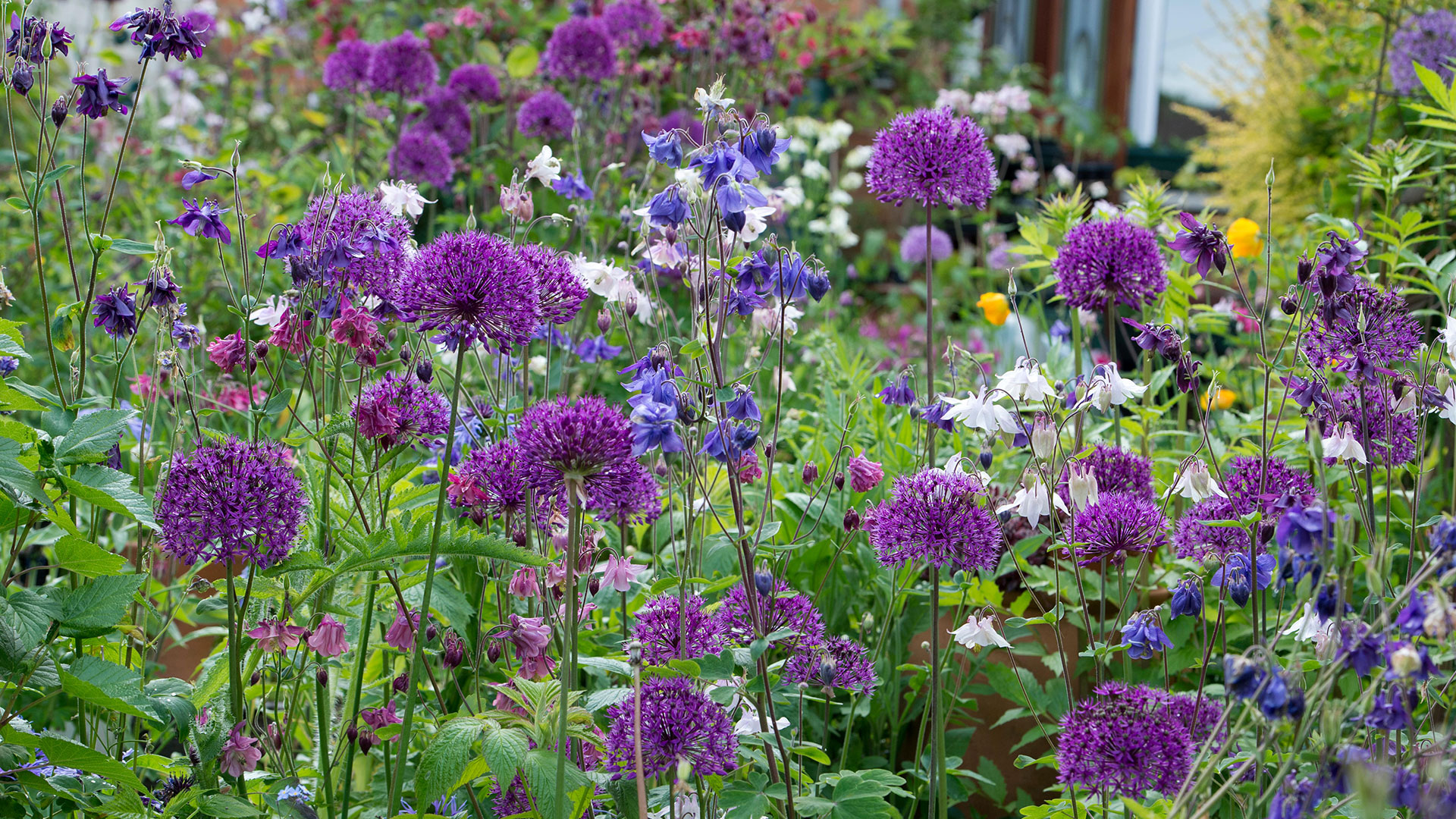
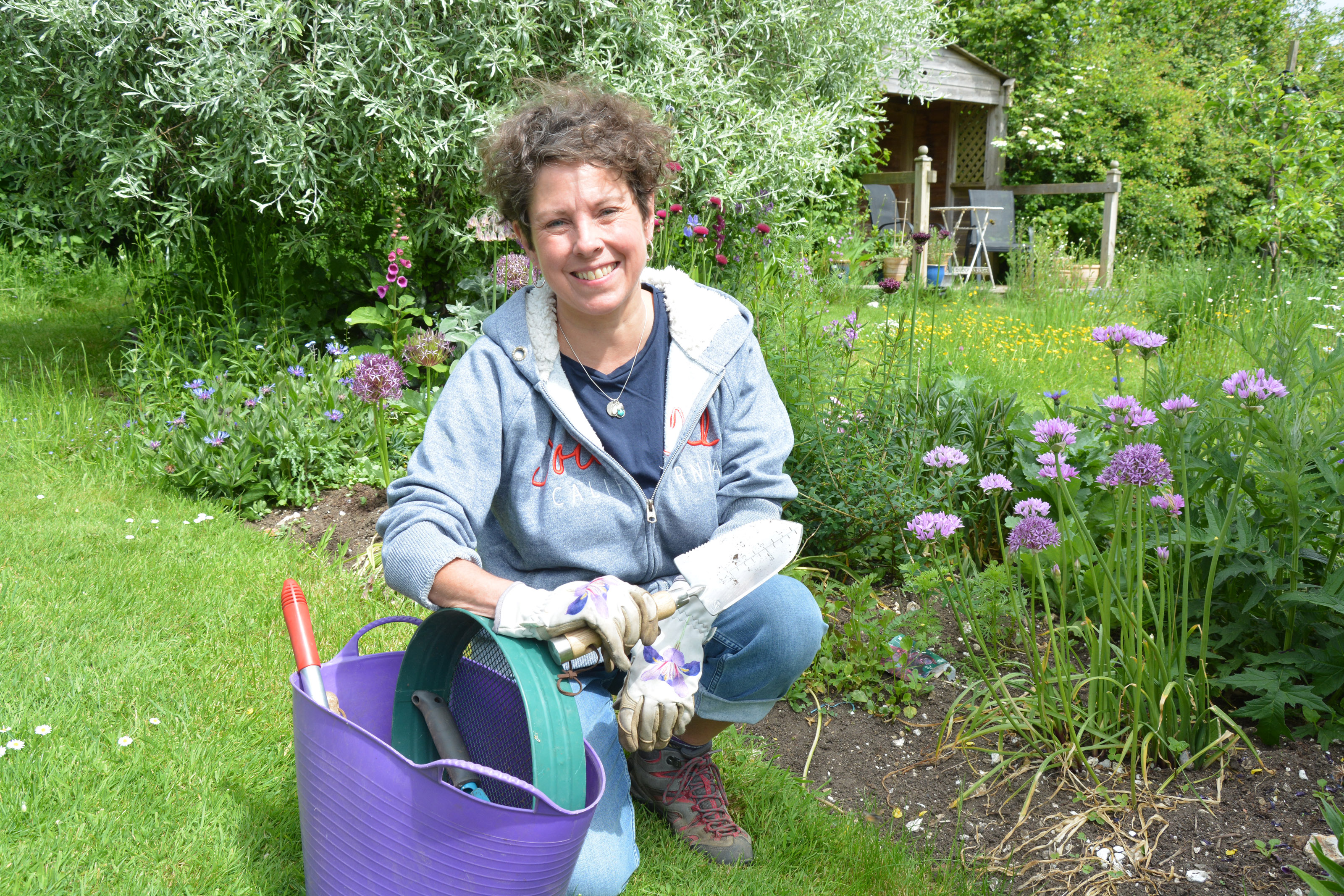
Deciding what to plant in September is an absolute joy because the soil should be perfect for receiving new plants.
Still warm from the summer, yet dampened by seasonal rain, it provides the perfect conditions for new roots to get established before plants go dormant in the winter. It’s also a good month for grabbing some bargains, as many garden centers and online retailers will be selling off old summer stock.
Top of your ‘what to plant in September’ list should be spring bulbs, as they start being available this month and it’s good to buy them early before the best ones sell out. They are an easy and versatile way of adding color to the garden, and happy to grow in borders, rock gardens, containers, and even in your lawn. If you buy a mix of varieties you can expect color and interest from the earliest days of spring right through into the summer. What’s not to like?
But it's not all about bulbs – there are lots of other lovely options for planting this month, too. The round-up below has plenty of tips on what to plant when, so you can prepare a bloom-filled garden for next year.
What to plant in September: 14 picks to fill your garden with now
Whether you want instant impact with pretty bedding plants or want to sow seeds or plant bulbs ready for early spring displays, our suggestions for what to plant in September will ensure there is plenty to admire in your plot during the cooler weather ahead.
Whatever flowers you plant this month, don’t forget about watering the plants while they get established, especially as September can often give us a warm, dry Indian summer.
Soil may also need enriching after a summer of growing, so dig in lots of well-rotted compost or manure, which will feed your new plants and also help the ground hold on to moisture.
1. Nectaroscordum
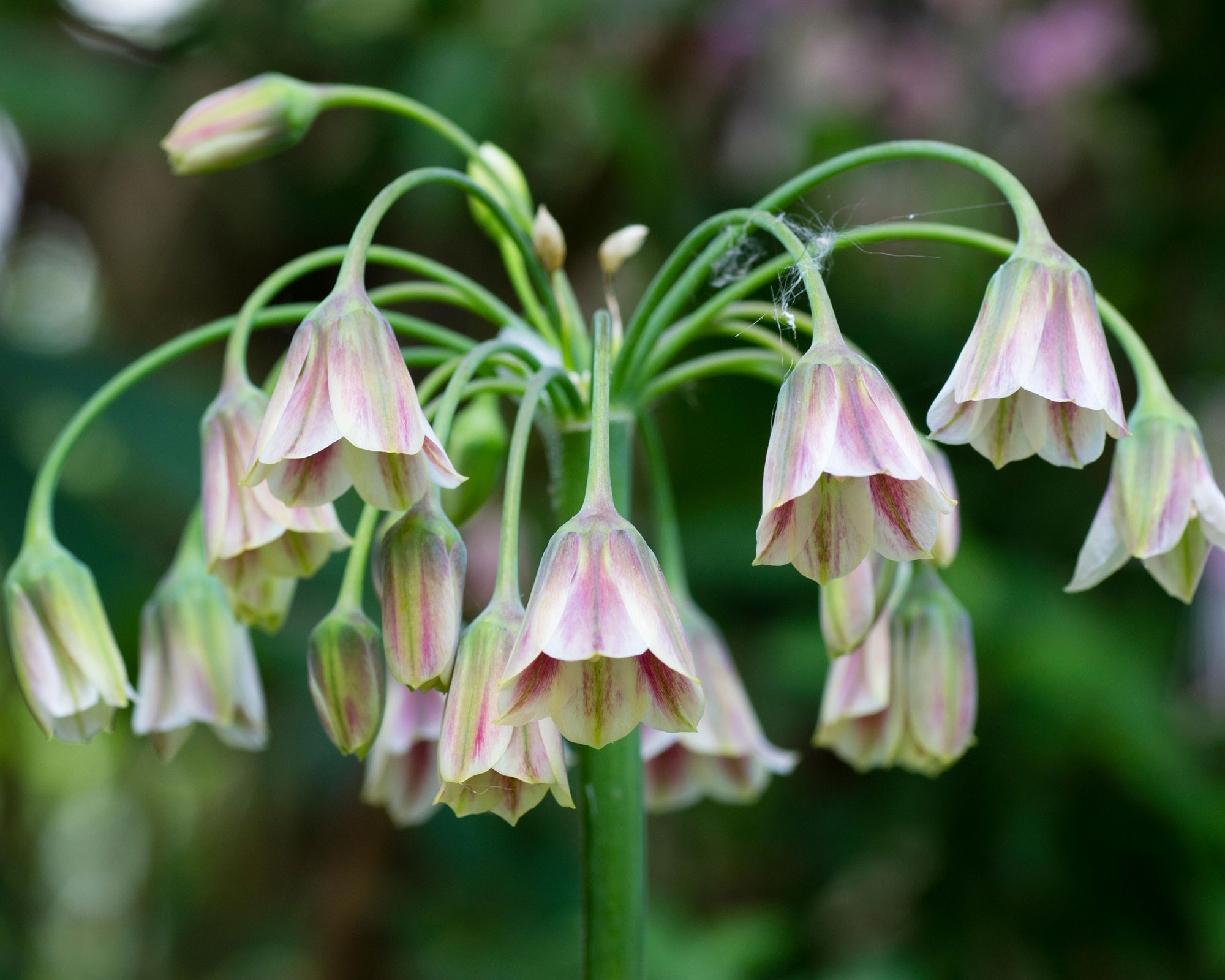
Nectaroscordum siculum or Sicilian honey garlic are unusual alliums that bring height and grace to borders
One of my favorite alliums for garden borders is Nectaroscordum siculum or Sicilian honey garlic.
Unlike most members of the onion family that produce circular heads of purple or white flowers, this allium opens up into umbrellas of pale cream blooms that are flushed with pink and have green tips.
Growing to almost 4ft (1.2m) in ideal situations, they continue to delight when flowers fade, producing arrow-head seed pods that grow upright from the tall, straight stem.
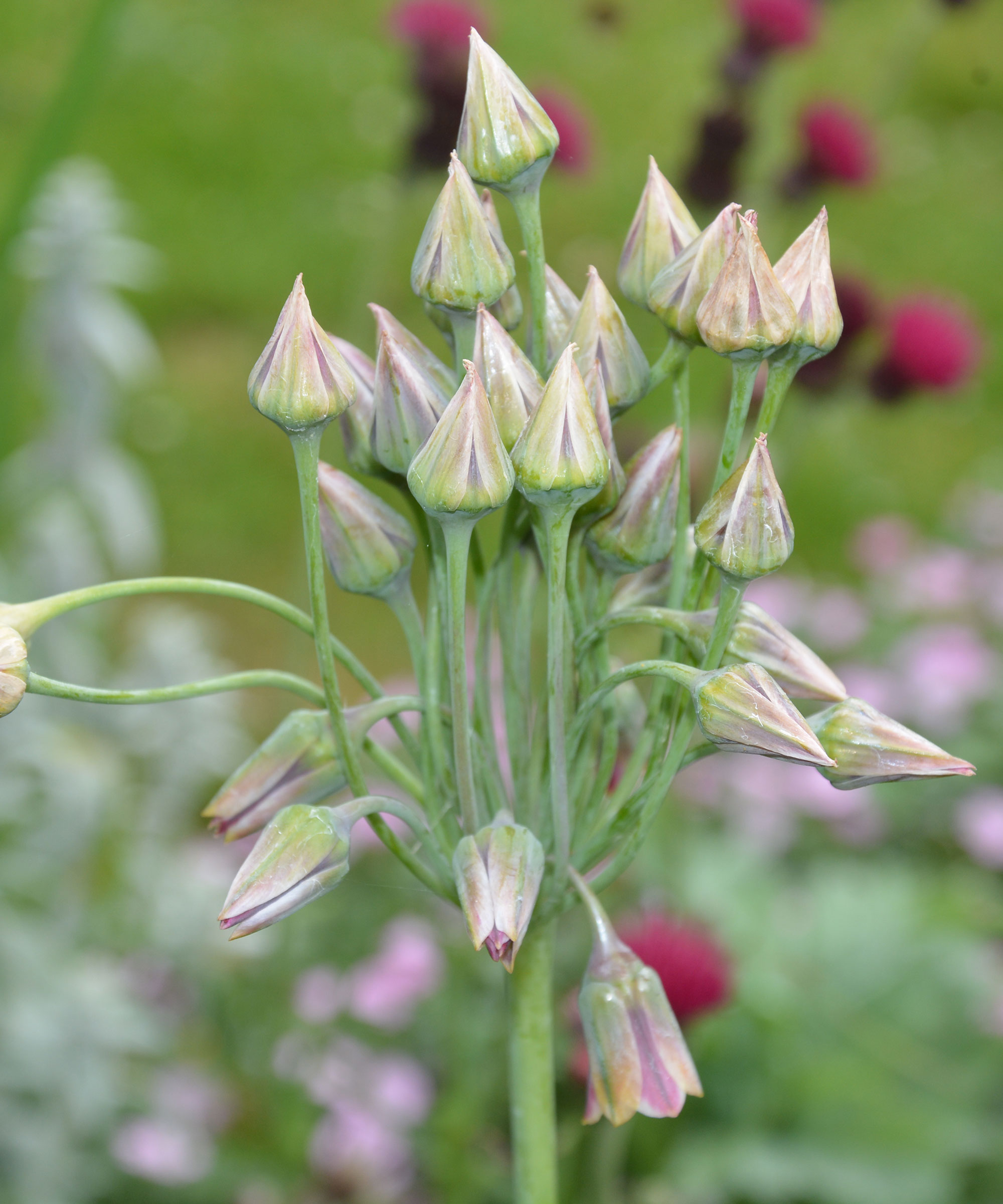
The arrowhead seed pods of Nectaroscordum siculum are worth keeping for garden interest
Plant the bulbs in free-draining soil in a sunny spot that has been enriched with well-rotted compost or farmyard manure. Set them at 2-3 times their own depth and a bulb’s width apart, ideally in clusters of odd numbers because even numbers of plants can look too regimented.
Firm the soil down gently over the top of the bulbs and water well and they should flower next spring.
Top tip: Nectaroscordum siculum can also be grown from seed but they will take around six years to flower.
2. Red hot pokers
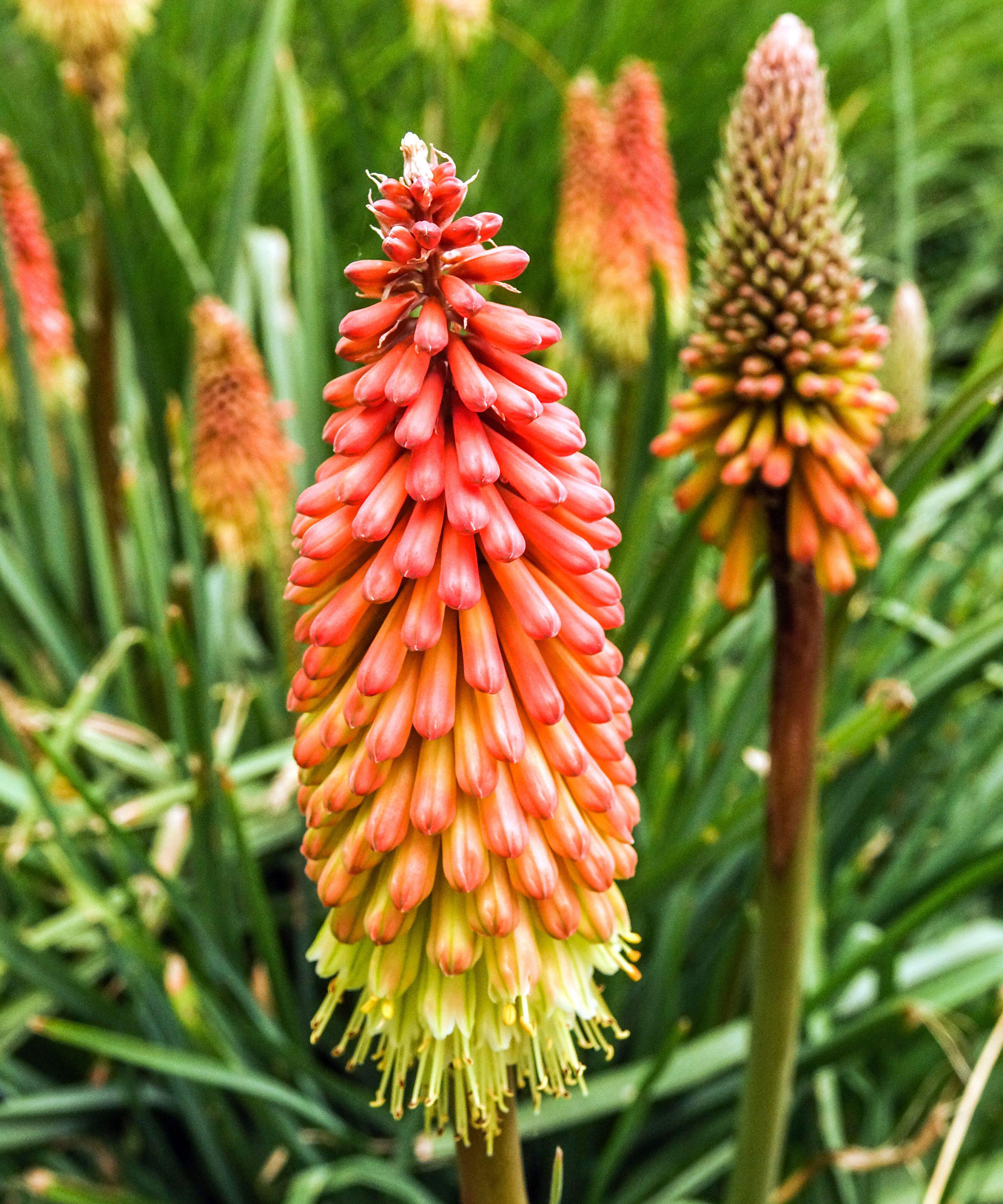
Red hot pokers are traditionally red, but yellow and cream varieties are also popular
For a bit of late summer heat, add some red hot pokers to your borders.
Also called kniphofias, these drought-tolerant plants have strap-like leaves and tall spires of glowing red florets, though they are also widely available in yellow and cream.
Though traditionally tall, dwarf varieties look lovely planted towards the front of your beds.
To plant, dig a hole that’s as deep as, but slightly wider than the plant’s root ball and fork in some well-rotted organic matter.
Stand the plant in water for around 30 minutes to saturate the root ball, then gently slide it from the pot and use your thumbs to loosen any roots that are constricted or circling the pot.
Then, set the red hot poker in the hole, and infill around the roots with soil and compost, firming it down as you go to knock out air pockets. Water well and mulch the root area with compost or manure to retain moisture.
Top tip: If you are planting in clay soil, fork up the sides of the planting hole to improve drainage so the roots don’t drown in an impermeable ‘bucket’ of water.
3. Sedum
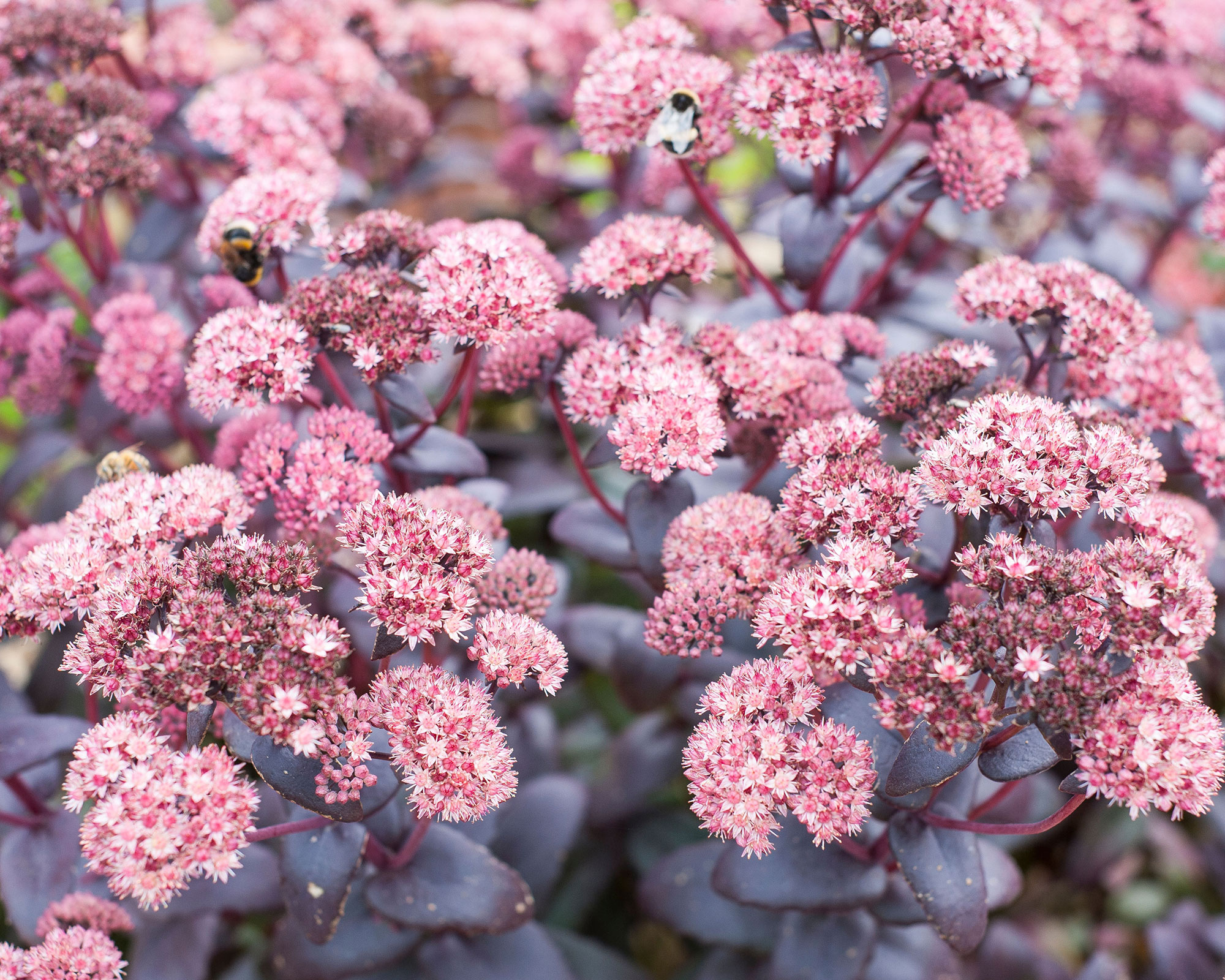
Many sedums have green leaves and pink flowers, but this ‘Purple Emperor’ is an eye-catching variety
Sedum, or stonecrop, are the perfect flower for autumn color and also provide essential late nectar for foraging bees and butterflies.
Also known as ice plants, they have fleshy leaves in shades of green and purple and spreading, flat clumps of flowers in various shades of pink.
Perfect plants for a low-maintenance garden border, they like a sunny spot and are one of the best drought-resistant plants, though young plants do need protection from slugs and snails. I find that a ring of wool deterrent pellets such as Slug Gone (available from Amazon) around plants keeps the pests at bay and also works as a mulch, keeping moisture in the soil.
Plant stonecrop at the front of a border or in containers of multipurpose compost with added grit to improve drainage.
Top tip: The Chelsea chop, when you remove one stem in three, will keep sedum plants neat and long-flowering through summer, and their faded flowerheads are attractive enough to leave attached in the fall.
4. Iris reticulata
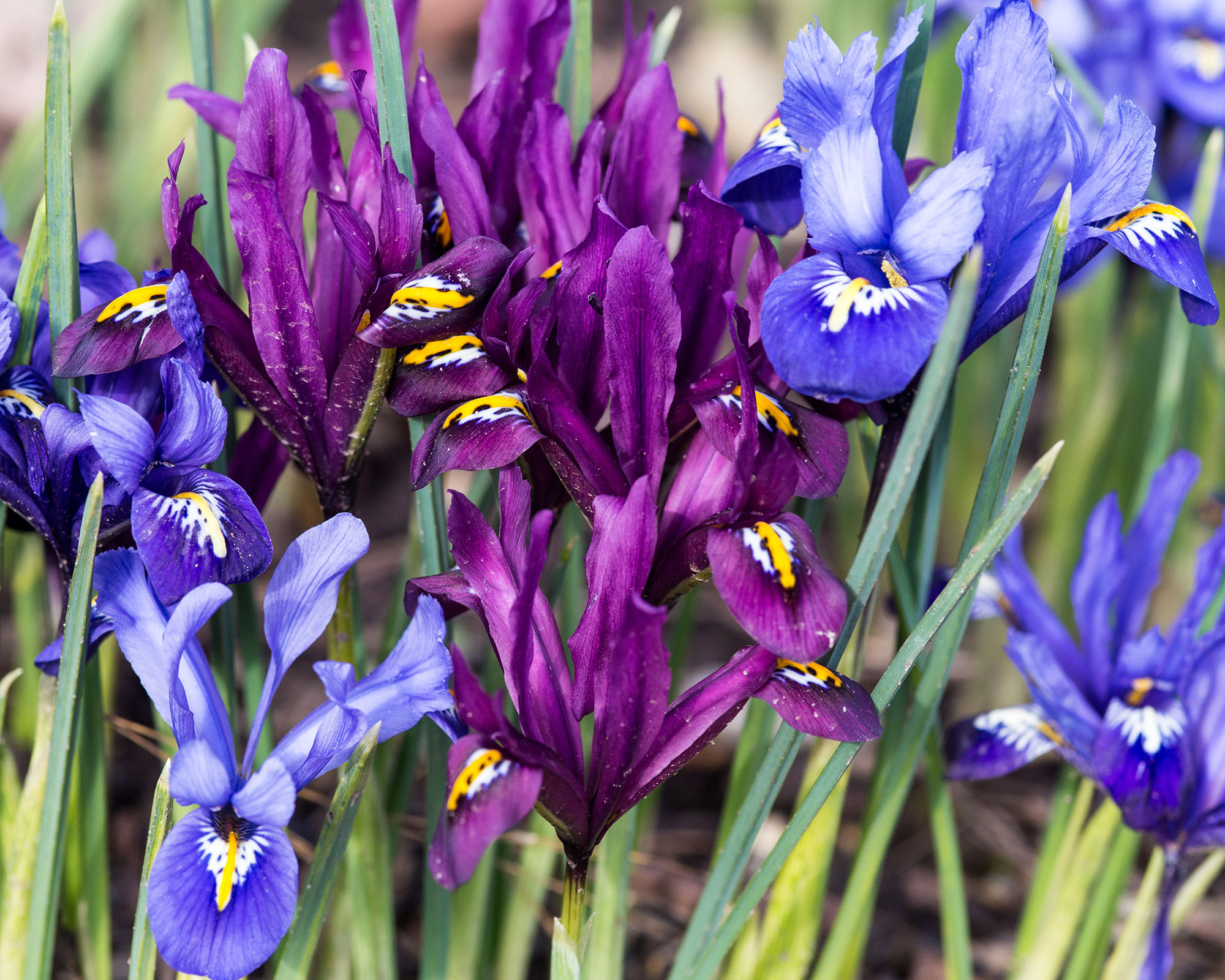
Iris reticulata are a lovely way of adding low-growing color to borders, rockeries, and containers
Iris reticulata are early-blooming spring flowers, grown from bulbs in a sunny spot with rich, free-draining soil.
A dwarf variety, their flowers are traditionally violet with yellow markings. However, newer varieties such as ‘George’ have striking pinky-purple petals while ‘Natascha’ has blue petals that are so pale they almost look white.
Iris reticulata, or reticulate irises, originally came from dry areas of Europe and work well at the front of borders as well as in pots. They are also worth considering as plants for rockeries.
Top tip: Plant the bulbs in autumn for spring flowers or if you can’t wait, buy ready-to-flower plants in late winter for an instant hit of color.
5. Verbascum
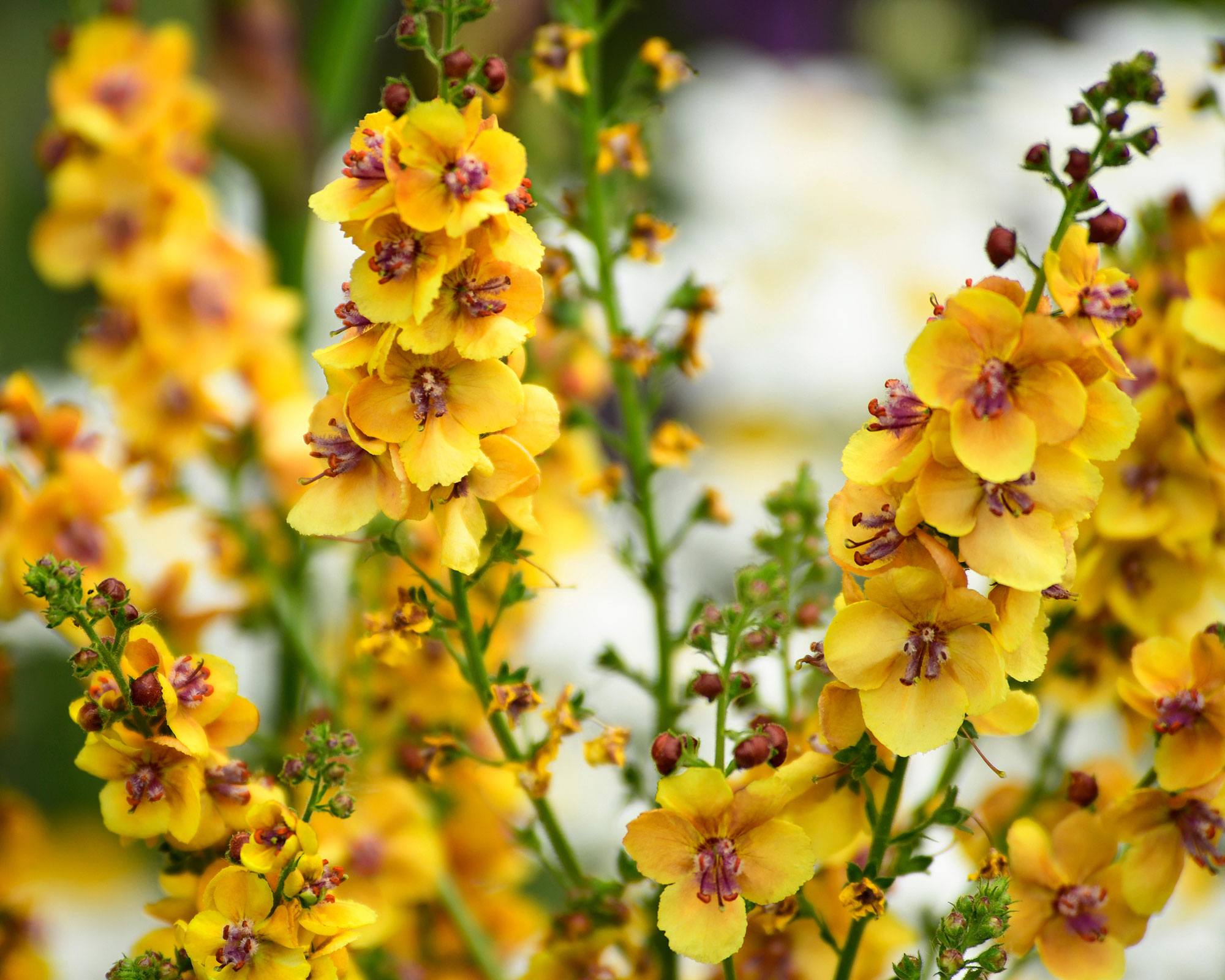
Verbascum, or mullein, such as this variety ‘Clemantine’ add height to borders and are good for cottage and contemporary gardens
If you’re looking to add height to a border, look no further than verbascum varieties, stately perennial or biennial plants with spires of clustered flowers in all shades from deep purple to creamy yellow.
They like neutral to alkaline soil that drains well and look wonderful as part of cottage garden planting schemes, but will also fit in well with more contemporary border planning ideas. Try them with ornamental grasses and bright hardy annuals such as poppies and cornflowers.
Verbascums, also known as mulleins, enjoy sun but will also thrive in partial shade and are perfect additions if you are creating a wildlife patch as they attract lots of beneficial pollinators.
However, they are susceptible to attacks by mullein moth caterpillars – yellow, black, and white-striped grubs that can do serious damage to your plants. The best defence is to pick them off and add them to the bird table.
Top tip: Verbascum flower early in the summer. If you cut back their flowered stems you should be rewarded with a second flush of blooms later in the summer.
6. Chrysanthemums
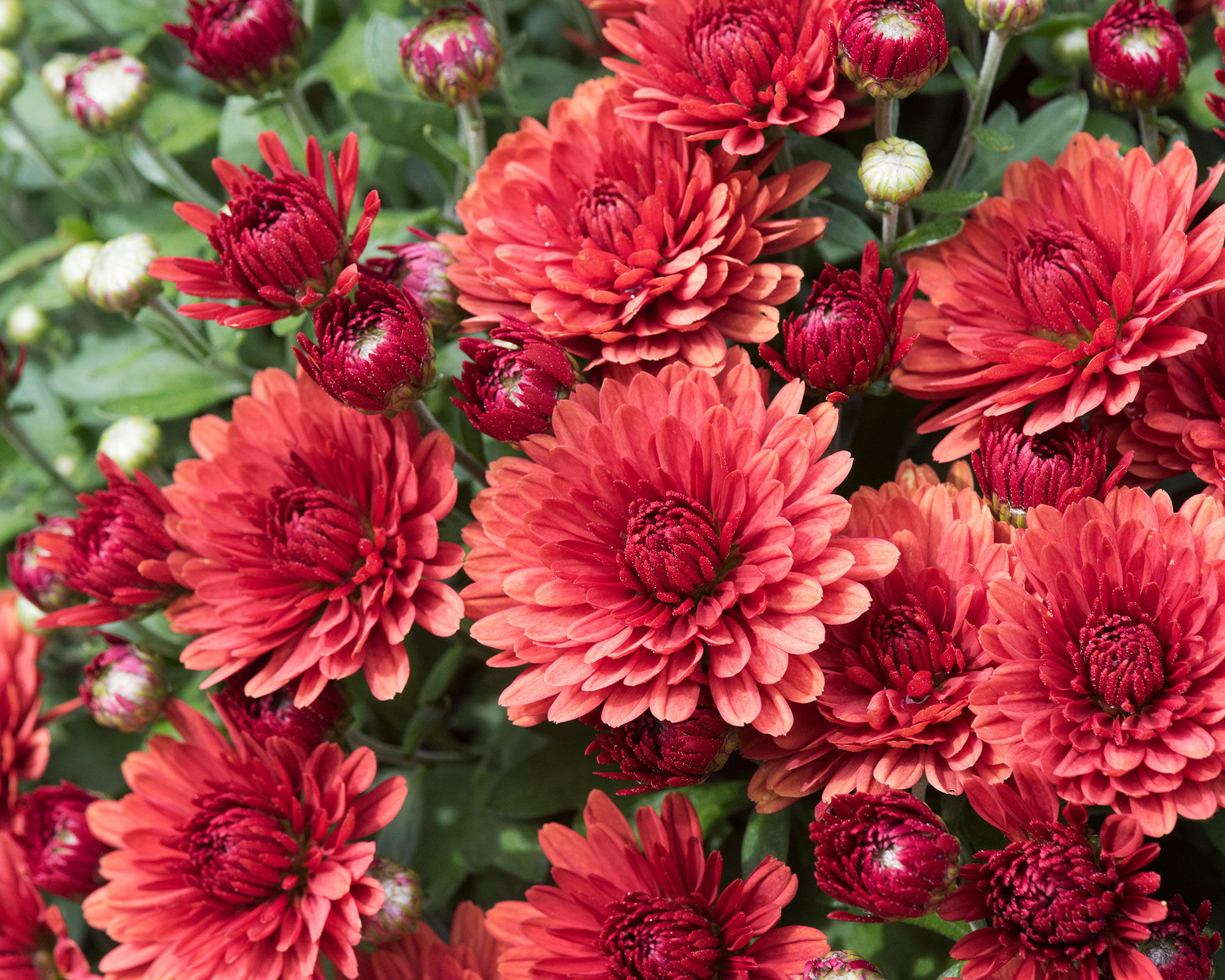
Bedding chrysanthemums bring a shot of low-growing color to borders and containers
Chrysanthemums, also known as ‘chrysanths’ and ‘mums’ were all the rage for a while, then fell out of favor and gained a reputation for being a bit boring and fuddy-duddy.
Now they are back in vogue and a top garden trend, so more people are enjoying the benefits of learning how to grow chrysanthemums. It's easy to see why too. Easy-going and with a wide range of colors, flower sizes, and heights, they are the slightly less flashy cousin of the dahlia and just as beautiful.
Although most chrysanthemums are bought as rooted cuttings and small plants in spring, garden centers and online suppliers will have lots of fantastic, bright bedding varieties in stock now, making them an easy addition to your list of what to plant in September.
These are usually dwarf plants that form clumps of gem-shade flowers in pinks, reds, russets, and oranges. They will flower long into the winter and again next spring.
Top tip: Deadheading flowers regularly will keep the blooms coming and the plants in a neat shape.
7. Biennial seedlings
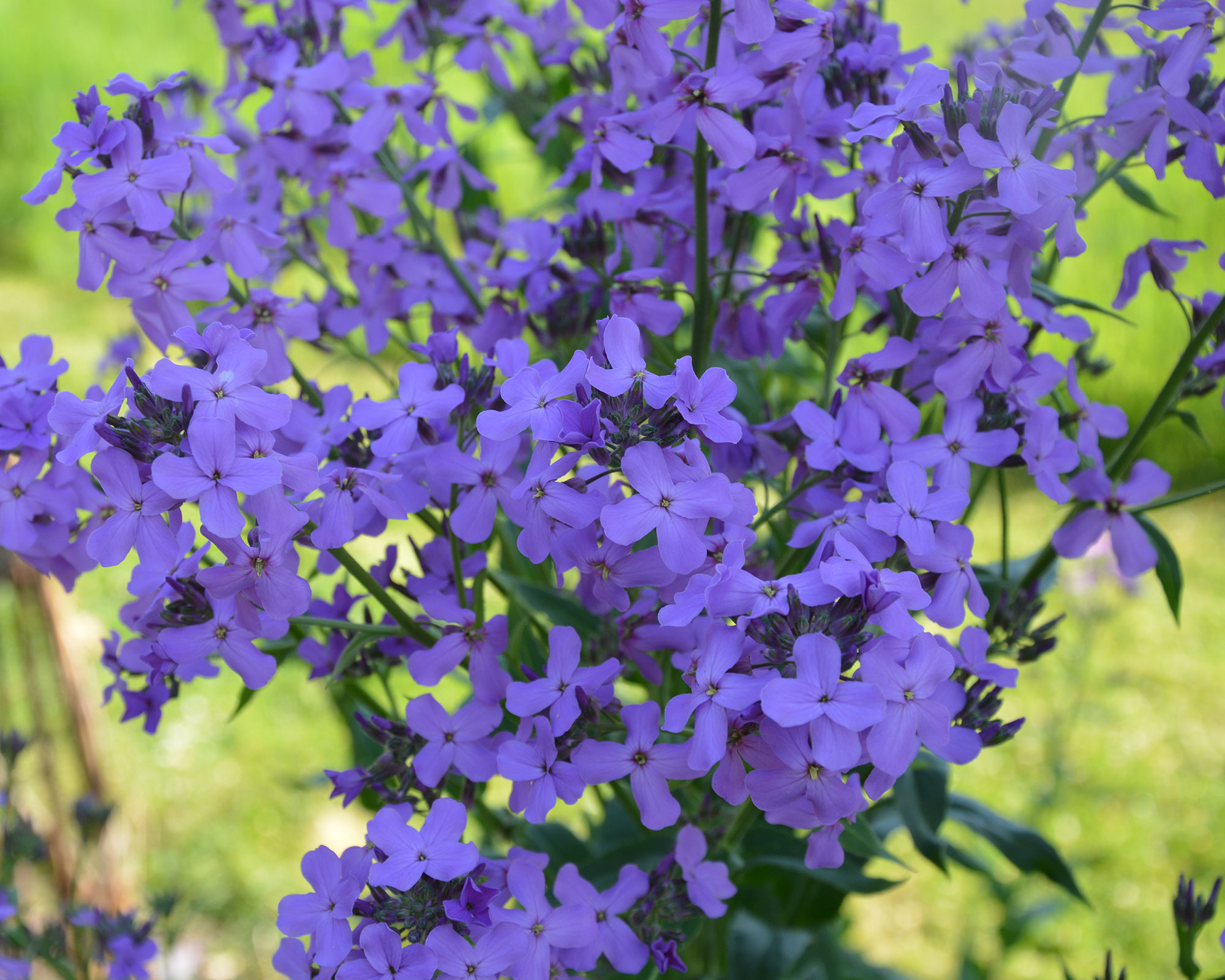
Sweet rocket is a beautiful, tall-growing early summer biennial
If you sowed a selection of biennials in spring and summer, the seedlings should be ready to move to their final growing place.
Biennials are plants that are sowed year and flower the next, and they include foxgloves, sweet rocket, wallflowers, and honesty.
Many of these plants will happily self-seed around the parent plant so if you are already growing them you may find seedlings springing up in unexpected (and unwanted) spots in your garden.
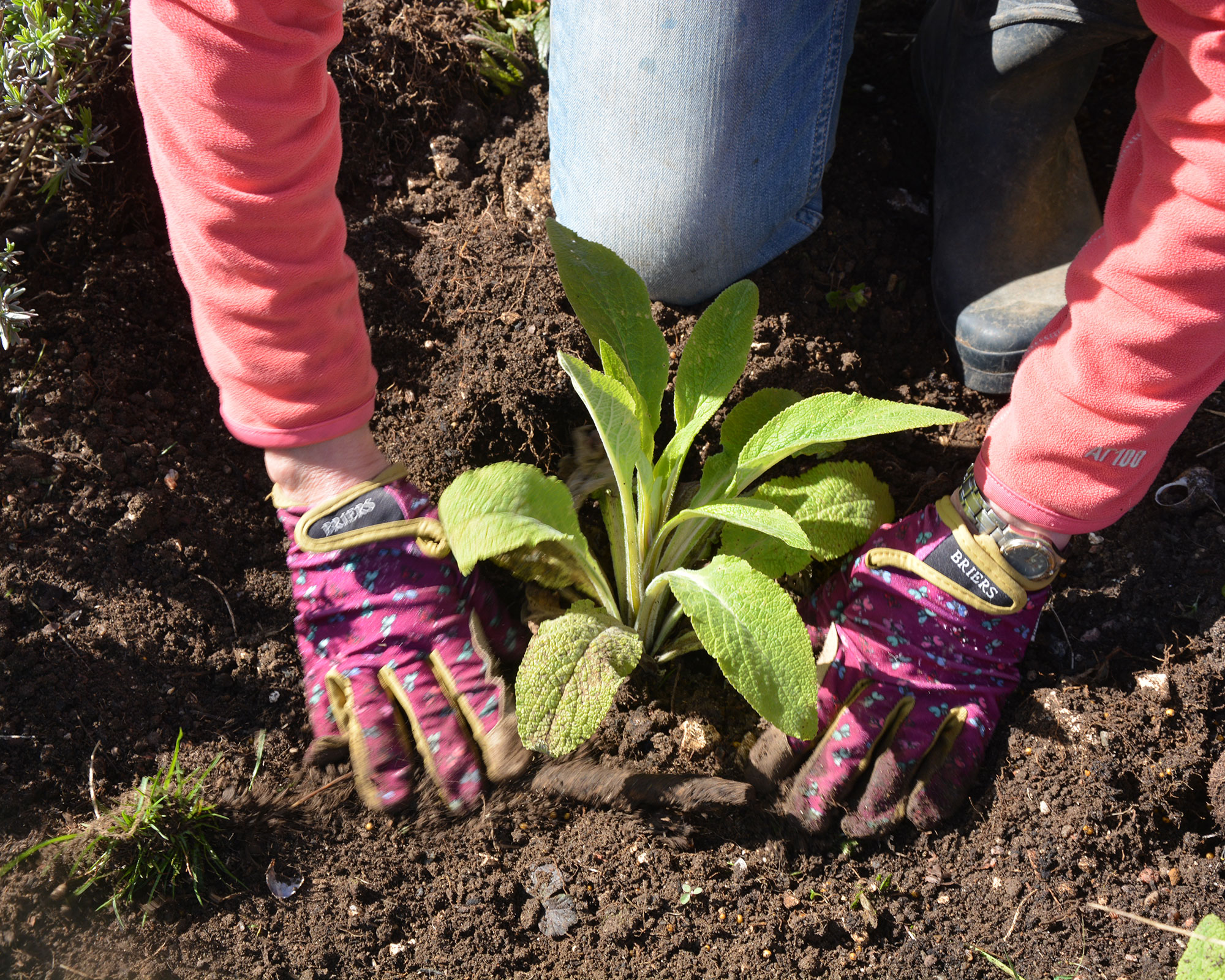
Plant biennial seedlings, such as this foxglove, where you want them to flower next summer
Carefully dig them up, keeping soil around the roots, and plant them where you wish, at the same depth as they were growing before. Keep them well-watered.
Alternatively, pot them up in peat-free compost and overwinter them in a cold frame or unheated greenhouse. Next spring, when the soil warms up, you can plant them out where you want.
Top tip: If pink and white honesty has self-seeded, either leave it where it is or add it to the compost heap if you don't want it. These plants have long, thick tap roots and don’t transplant well.
8. Cyclamen
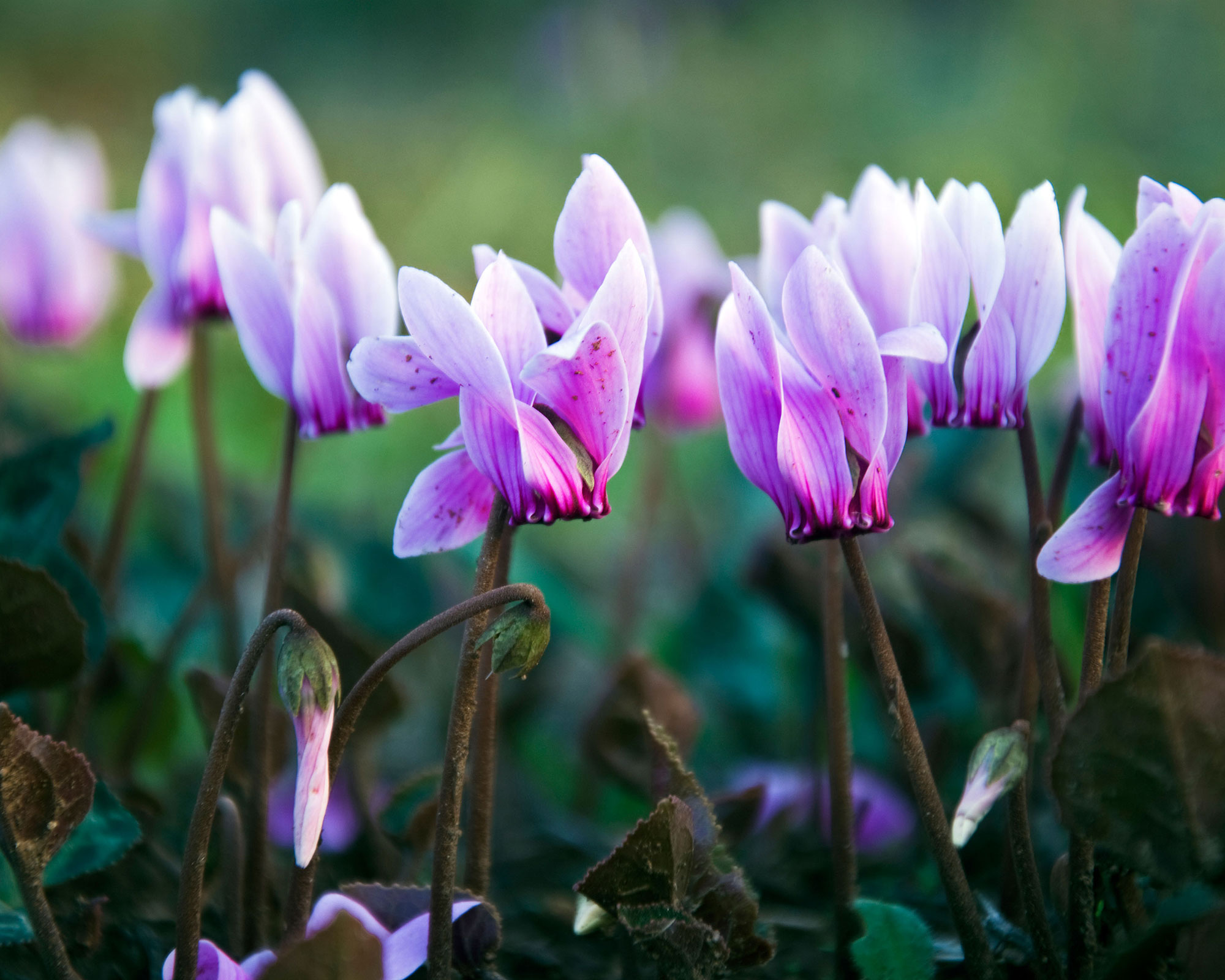
Cyclamen hederifolium flowers bring color to the garden in fall and early winter
With their jewel-colored flowers and interestingly patterned leaves, jaunty little cyclamen are an excellent choice for what to plant in September.
As great shade-loving plants, they seem to glow out of the gloom, and their corms will multiply over the years. They also boost their numbers by self-seeding.
The best outdoor varieties are Cyclamen coum, which have green leaves with white streaks and pretty little flowers in shades of pink, red, and white, and Cyclamen hederifolium, with their pink and white flowers and leaves patterned like ivy.
Both varieties thrive in humus-rich soil and are lovely under trees and shrubs.
Top tip: After flowering, cyclamen seedpods are held on curled stems that slowly unwind as they ripen, lowering the precious seeds down to the soil.
9. Ornamental brassicas
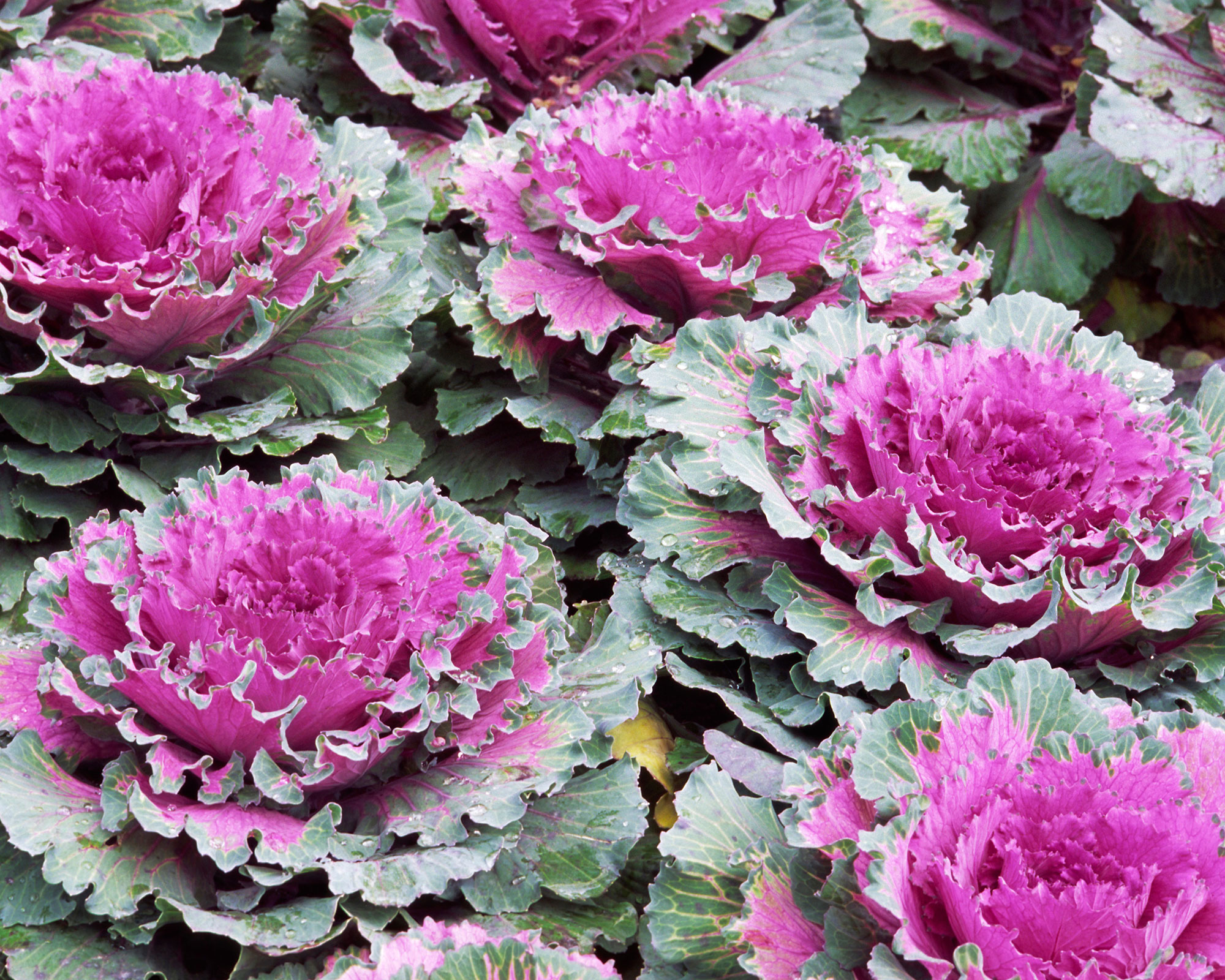
Ornamental cabbages and kales are an unusual addition to flower beds and containers
There's no need to laugh at this suggestion for what to plant in September! Ornamental brassicas are a far cry from soggy over-boiled cabbage and the smell of old washing.
Many of them produce brightly-colored leaves in varying shades of greens with mauve, purple, and steely tints to provide a cool foil to the burnished and bright colors of spring and autumn bedding, their color often deepening as the temperature falls.
Best of all, you plant them at a time when cabbage white butterflies are no longer on the wing, so there's no need to be on caterpillar watch for weeks on end.
Ornamental cabbages do well in borders and also look eye-catching in smaller planting schemes contained in pots, baskets, and rockeries.
Top tip: These pretty plants are edible when they are young, though their taste is stronger than the brassicas we grow for cooking, and not as palatable.
If you'd prefer to learn how to grow winter brassicas to eat rather than purely for ornamental purposes, our guide has tips on growing everything from cabbage and cauliflower to kale and sprouts.
10. Dierama
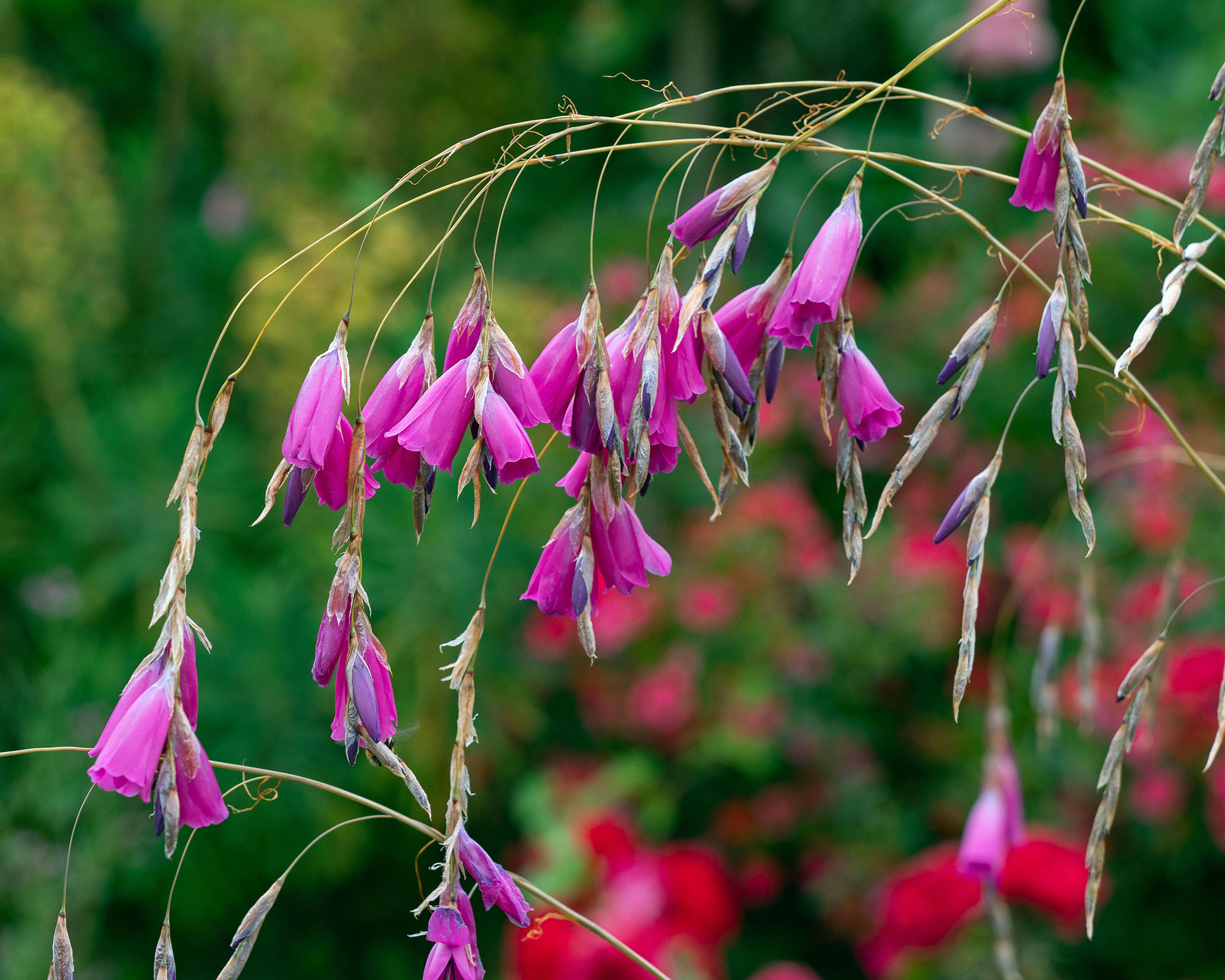
Dierama pulcherrimum or angel's fishing rods have a delicate beauty
If you have the patience, this month is a good time to sow the seeds of Dierama pulcherrimum, or angel's fishing rods.
You need to be patient because the plants can take up to five years to reach flowering maturity, but the end result is delicate and beautiful plants with thin, strap-like leaves and gracefully drooping skeins of bells – hence their name – in shades of deep pinks and mauves.
If you are already growing the plant, collect the seeds as soon as they are ripe (our guide on collecting seeds from flowers explains how to do this). When you sow, scatter seeds thinly on the surface of a tray of seed compost and don't cover with more compost or vermiculite as light is needed for germination.
Prick out the seedlings when large enough and grow on until they reach a size that will cope with being planted out somewhere sunny with free-draining soil.
Although dierama look wonderful growing among ornamental grasses close to water, the corms that develop from their seeds as they mature are prone to rotting and need a dry site.
Top tip: Dierama will grow in containers, but are much happier in the soil. In winter, mulch corms with well-rotted compost or manure if very cold weather is forecast.
11. Violas
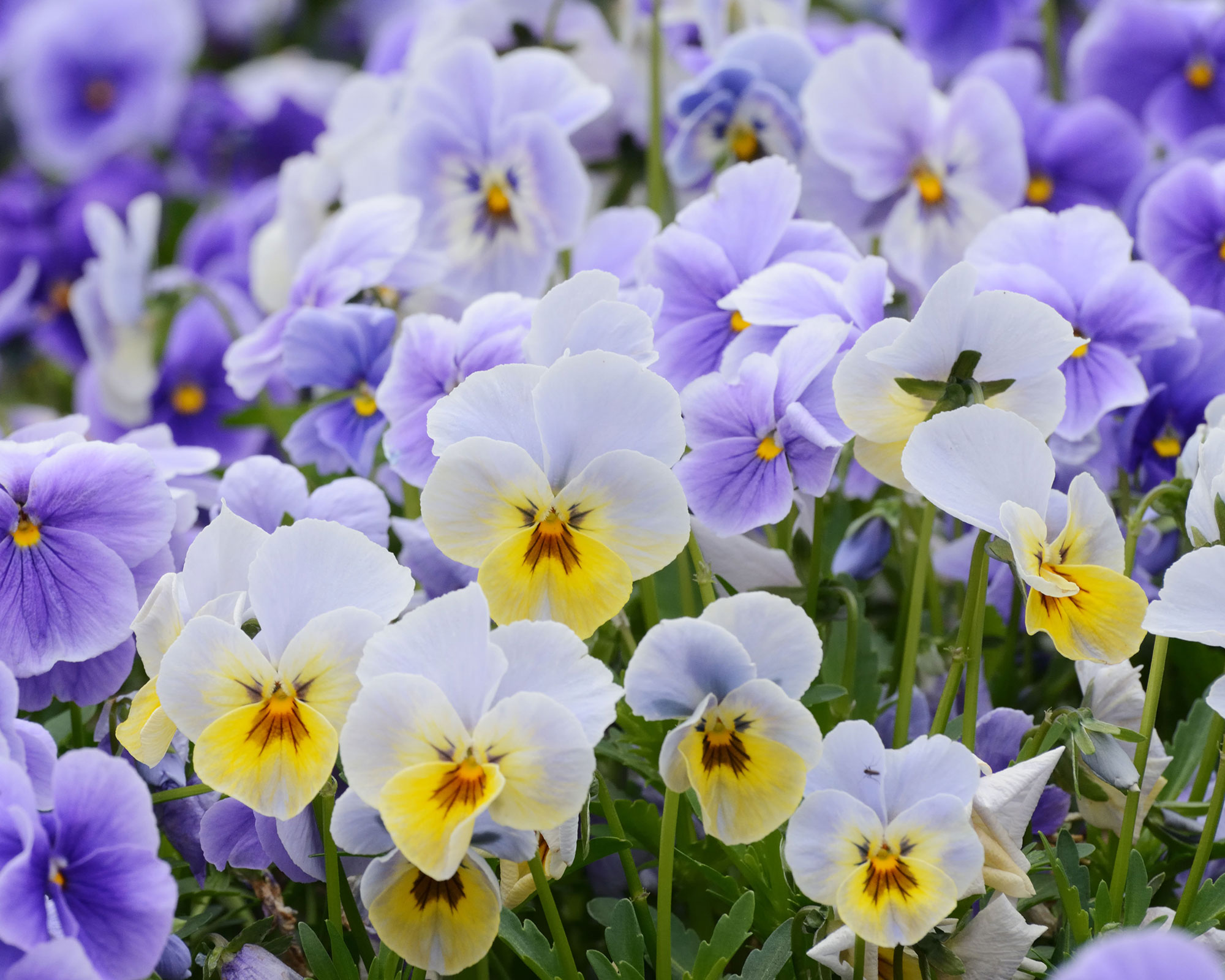
Small violas come in a range of shades and are easy to sow now for spring bedding
Violas are a spring bedding stalwart. Smaller than pansies, they are less likely to have their petals damaged by winter weather and will happily hunker down and sit out the worst of the weather before springing back to life when conditions improve.
There are many varieties to choose from if you're thinking about what to sow in September, from the purple and yellow old-fashioned favorite ‘Johnny Jump Up’ to the multi-colored ‘Chicky Chicks’ and ‘Pink Halo', which have pink-mauve petals with darker inky rings and yellow centers that look like slightly squashed-up faces.
Sow the seeds in a tray of dampened seed compost, cover with a little more compost and germinate on a warm, light windowsill. Prick out seedlings when they are large enough to handle and pot them on in peat-free compost. There are tips on how to transplant seedlings in our guide.
Harden off plants in spring and plant them out when the weather warms.
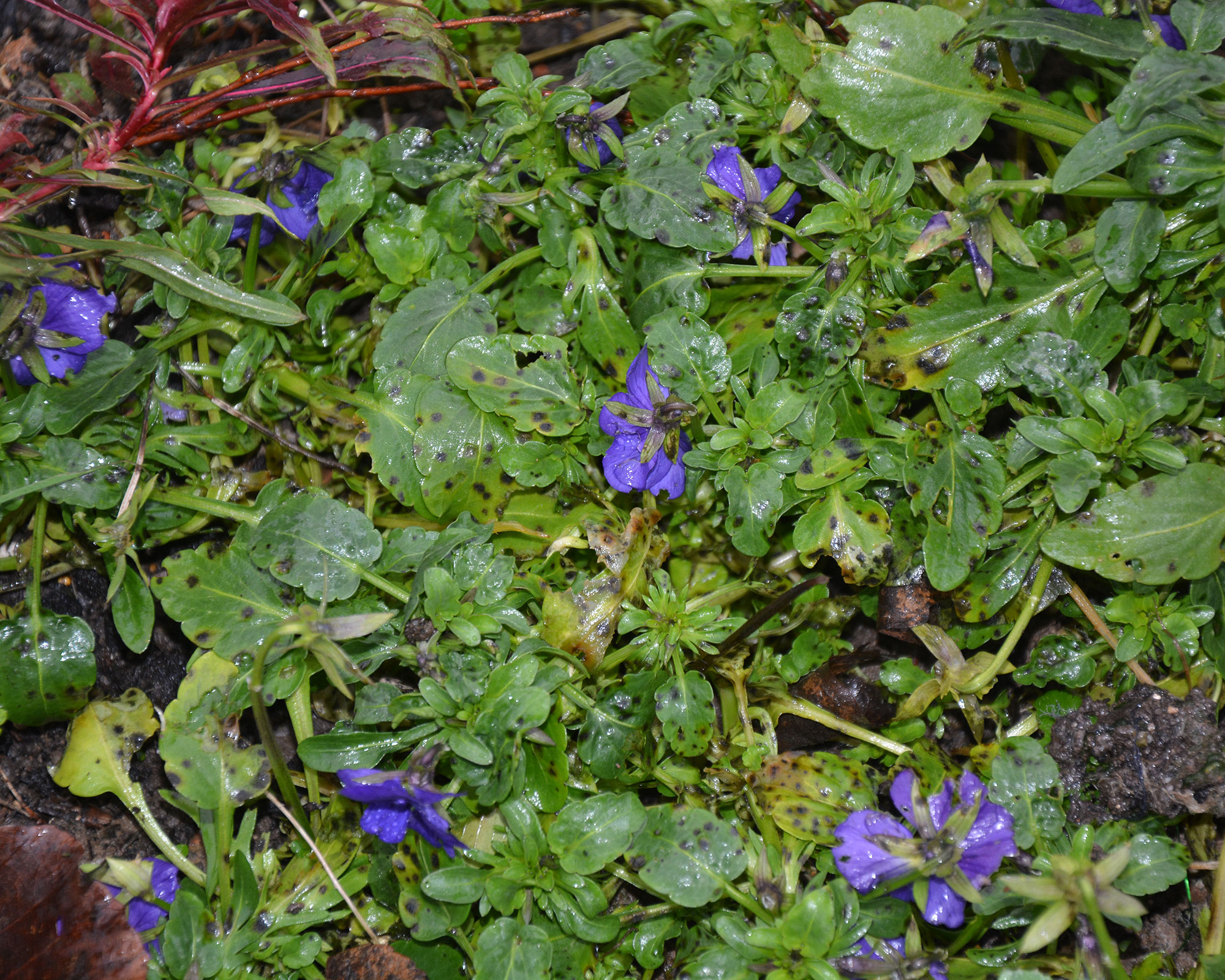
Leaf spot, seen here on a clump of violas, is a common fungal problem for the pansy family
Top tip: Violas and pansies are prone to a fungal disease called leaf spot, which causes oily dark patches to appear on the leaves, and weakens the plants. Avoid it by planting homegrown plants in areas of the garden where violas and pansies have not grown before.
12. Poached egg plants
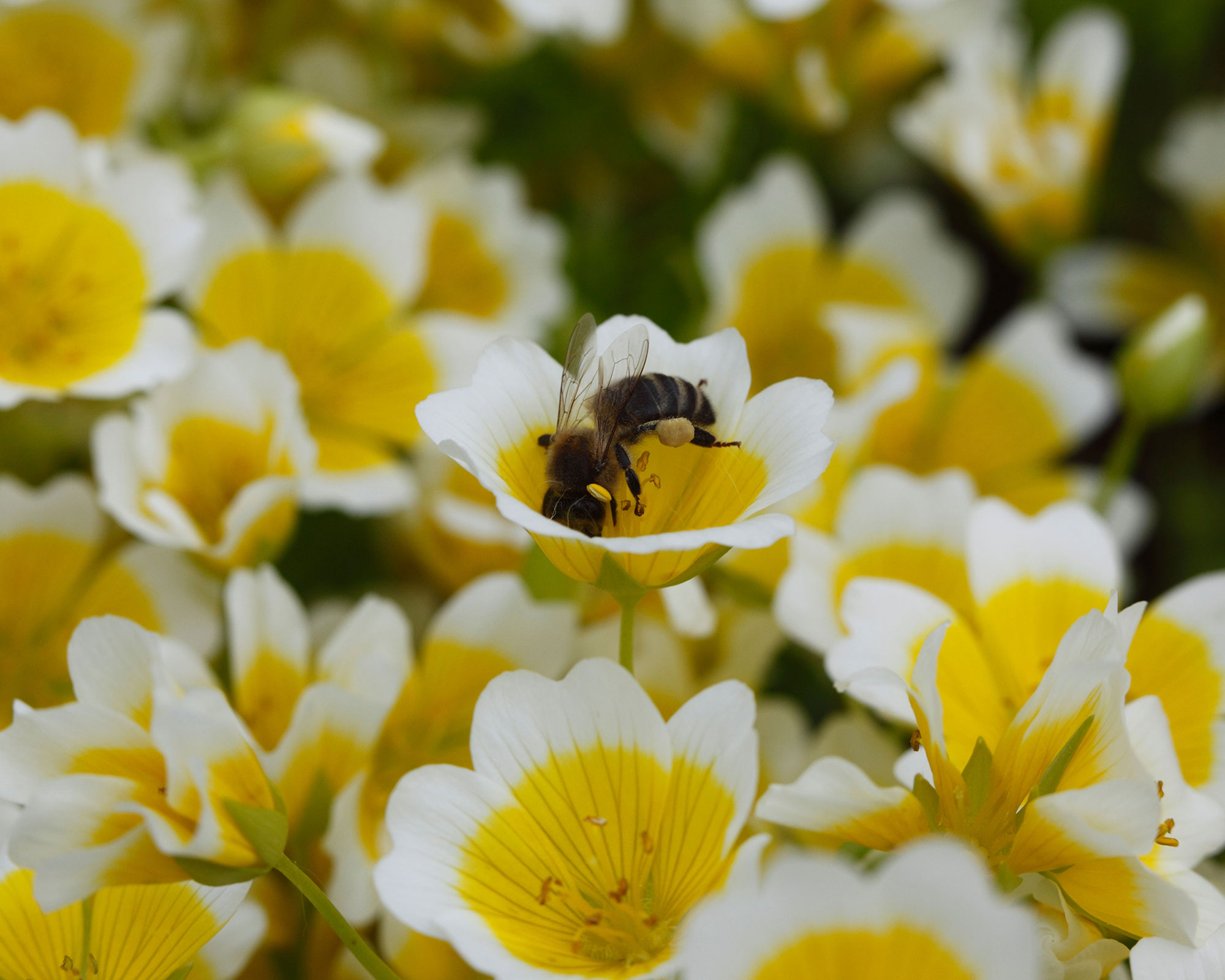
Pretty poached egg plants are one of the easiest hardy annuals to sow
Easy to grow and with sunny faces, poached egg plants (Limnanthes douglasii) are the cheeky, cheerful chappies of the spring and summer garden.
Low-growing, with vibrant green leaves and white flowers with yellow centers, they self-seed with ease and are ideal for the front of borders, as ground cover, and as path edging plants.
They like full sun and are hardy, so sow them now in soil that has been cleared of weeds and stones, raked until it is fine and crumbly, and watered.
Scatter the seeds thinly, cover them with a little more soil and label the site so you don’t accidentally disturb them. It’s also worth sprinkling some pepper dust over the top to keep off cats and pests.
The seeds will spend winter in the soil and start to germinate when the weather warms up next spring, and will flower all summer and into the fall.
Top tips: Poached egg plants are popular with pollinators as well as insects that prey on garden pests such as aphids, so use them as a companion planting aid and sow a few seeds around your fruit and veg patch.
13. California poppies
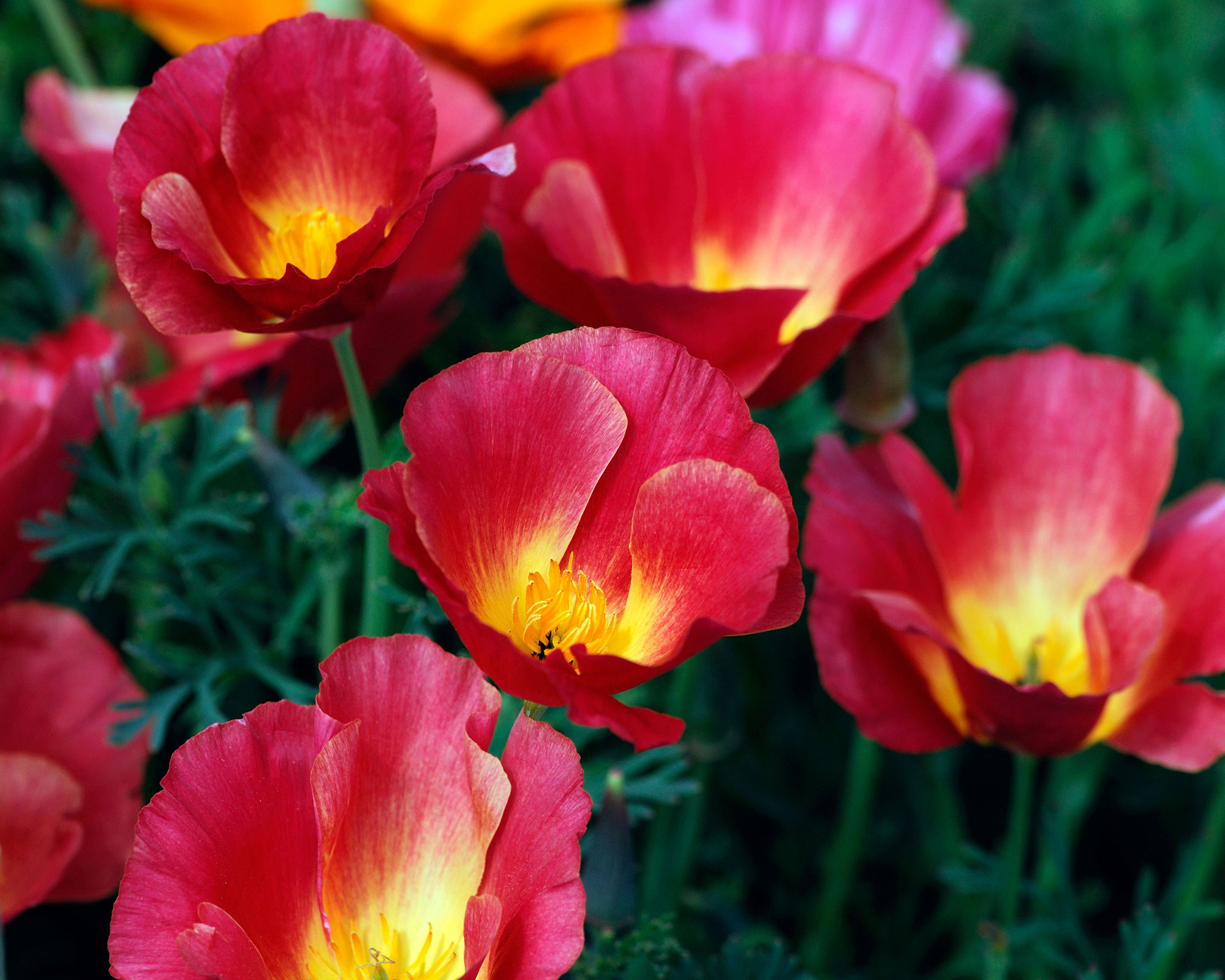
California poppies are usually orange but there are some stunningly vibrant red and cool cream varieties too
California poppies, also known as Eschscholzia californica, are cheery annuals that spread pops of color wherever they are sown.
Hailing from – you guessed it – California, where they are the State Flower, their orange variant is the most commonly seen, though they also come in shades of brilliant red, yellow and cool cream.
Glossy flowers ride high above soft ferny leaves, and their furled petals open as the sun passes over, following it on its daily course.
Sow now in well-prepared soil and look forward to long-lasting color well into the fall. The great thing about these flowers is they don’t mind poor soil, as long as they get lots of sun, so they are perfect for dry areas of the garden.
Top tip: Orange is the dominant color form and self-seeded offspring of differently colored California poppies will probably come up orange the following year.
14. Malope Trifida 'Vulcan'
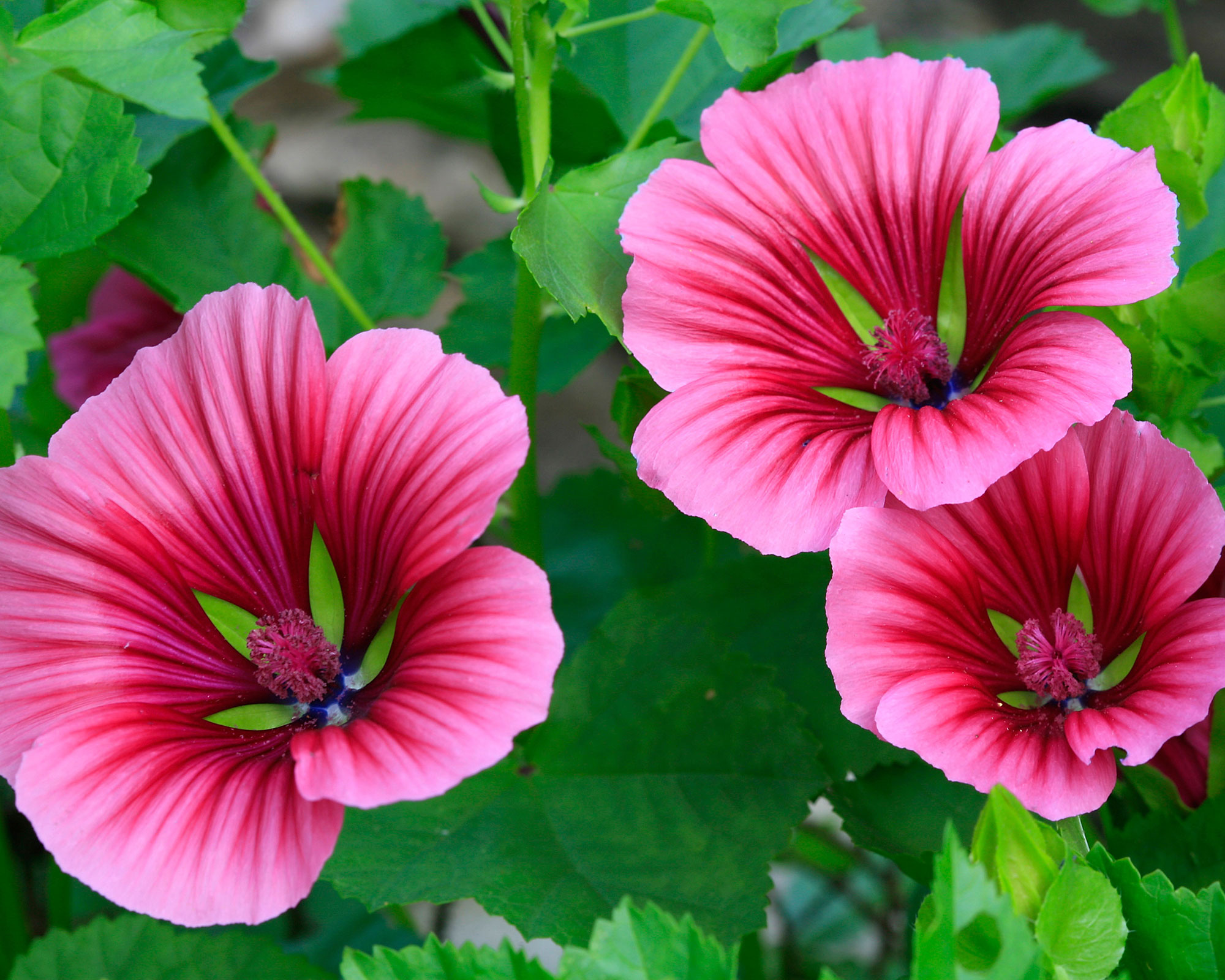
Show-stopping Malope trifida 'Vulcan' is easy to grow despite its exotic appearance
If you are looking for a floral show-stopper that is one of the best low-maintenance plants, you won't go far wrong with Malope trifida ‘Vulcan’.
A hardy annual despite its exotic appearance, this variety of stately mallow produces a profusion of glossy pink-purple flowers with lime-green centers, making it an interesting one to add to your list of what to plant in September.
Growing to 3ft (1m), it likes a sunny, well-drained spot and although it can also be sown in spring, seeds started now will have a head start on later sowings and will flower sooner.
As an added bonus, if you sow two or three batches over six weeks, you will get a prolonged flowering season.

Sow malope seeds into sieved and dampened seed compost
Sow them undercover in trays of sieved and dampened seed compost.
Tamp the compost flat so it provides a secure surface for germination and add a lid to the seed tray. Set it somewhere light, such as a greenhouse or cold frame, and the hardy annual seeds will germinate in a few weeks.
They can be pricked out and potted on into peat-free compost and overwintered in the greenhouse.
Top tip: ‘Vulcan’ blooms are lovely as a cutting garden flower for indoor arrangements, but don't start cutting them as soon as they start to appear on the plant as you’ll remove lots of buds as well. Wait a couple of weeks until the plant has really got established and is throwing out lots of blooms, and then start harvesting.

Ruth is the gardening editor of Amateur Gardening magazine and spends her working days carrying out, writing about and photographing the tasks the readers should be carrying out each week, as well as testing many of the new products that arrive on the gardening market. She is horticulturally trained, with a qualification from the Royal Horticultural Society.
